This is not an exact answer to this question, but since I arrived here based on a search, I'd like to answer the related question of how to create (not fit) a piecewise linear function that is intended to represent the mean (or median, or some other other function) of interval data in a scatter plot.
First, a related but more sophisticated alternative using regression, which apparently has some MATLAB code listed on the wikipedia page, is Multivariate adaptive regression splines.
The solution here is to just calculate the mean on overlapping intervals to get points
function [x, y] = intervalAggregate(Xdata, Ydata, aggFun, intStep, intOverlap)
% intOverlap in [0, 1); 0 for no overlap of intervals, etc.
% intStep this is the size of the interval being aggregated.
minX = min(Xdata);
maxX = max(Xdata);
minY = min(Ydata);
maxY = max(Ydata);
intInc = intOverlap*intStep; %How far we advance each iteraction.
if intOverlap <= 0
intInc = intStep;
end
nInt = ceil((maxX-minX)/intInc); %Number of aggregations
parfor i = 1:nInt
xStart = minX + (i-1)*intInc;
xEnd = xStart + intStep;
intervalIndices = find((Xdata >= xStart) & (Xdata <= xEnd));
x(i) = aggFun(Xdata(intervalIndices));
y(i) = aggFun(Ydata(intervalIndices));
end
For instance, to calculate the mean over some paired X and Y data I had handy with intervals of length 0.1 having roughly 1/3 overlap with each other (see scatter image):

[x,y] = intervalAggregate(Xdat, Ydat, @mean, 0.1, 0.333)
x =
Columns 1 through 8
0.0552 0.0868 0.1170 0.1475 0.1844 0.2173 0.2498 0.2834
Columns 9 through 15
0.3182 0.3561 0.3875 0.4178 0.4494 0.4671 0.4822
y =
Columns 1 through 8
0.9992 0.9983 0.9971 0.9955 0.9927 0.9905 0.9876 0.9846
Columns 9 through 15
0.9803 0.9750 0.9707 0.9653 0.9598 0.9560 0.9537
We see that as x increases, y tends to decrease slightly. From there, it is easy enough to draw line segments and/or perform some other kind of smoothing.
(Note that I did not attempt to vectorize this solution; a much faster version could be assumed if Xdata is sorted.)



